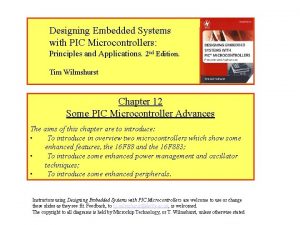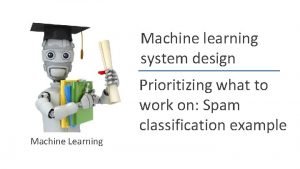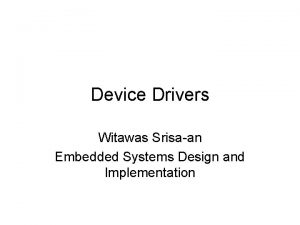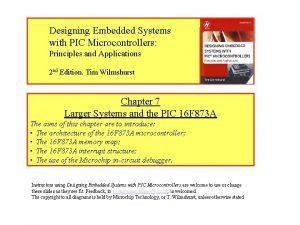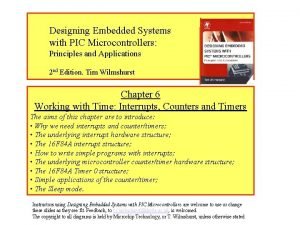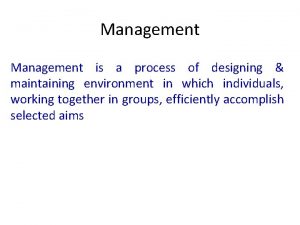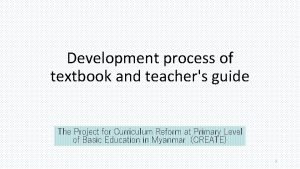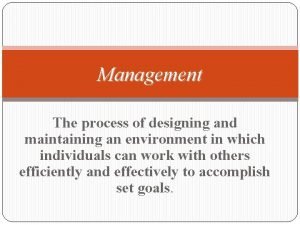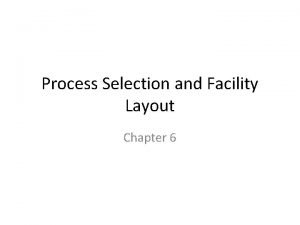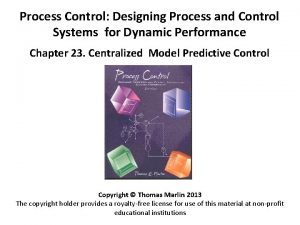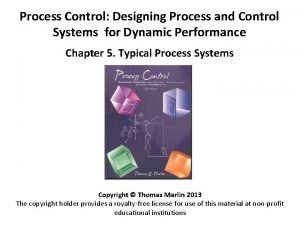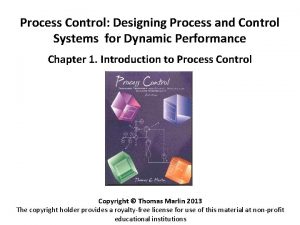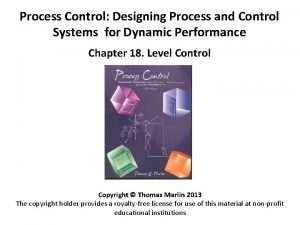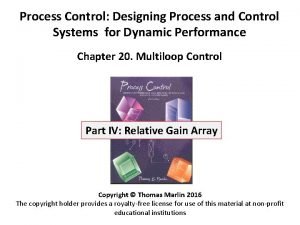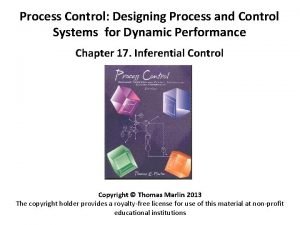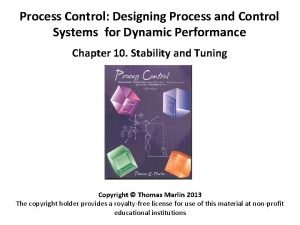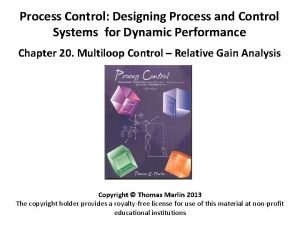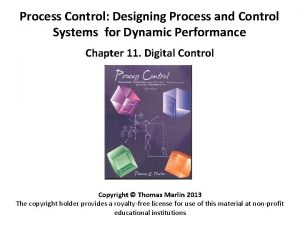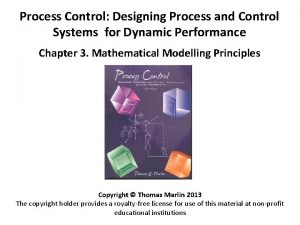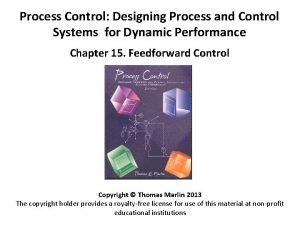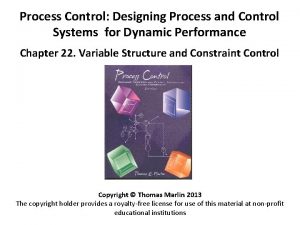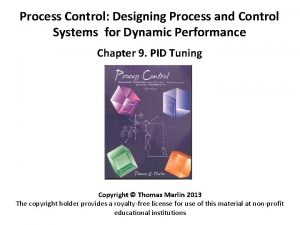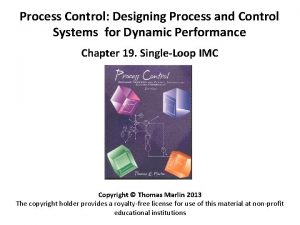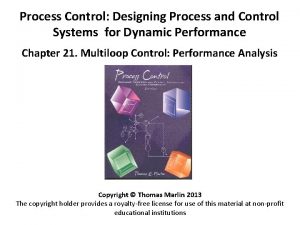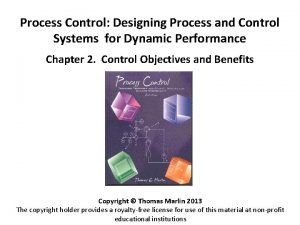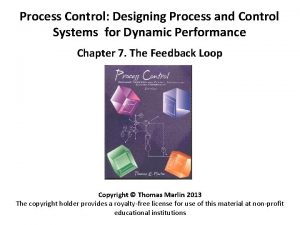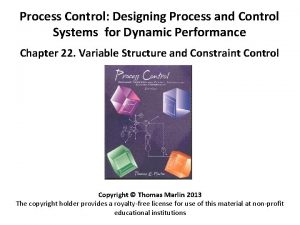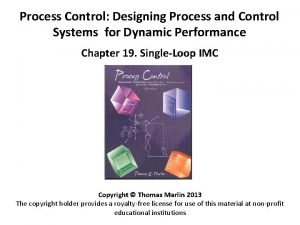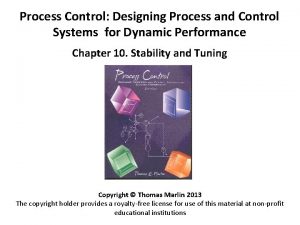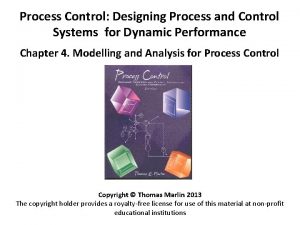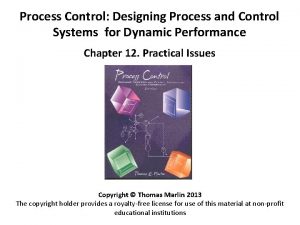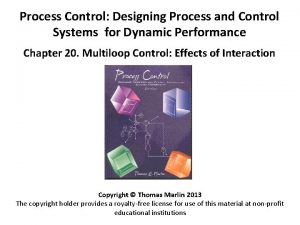Process Control Designing Process and Control Systems for








































- Slides: 40

Process Control: Designing Process and Control Systems for Dynamic Performance Chapter 14. Cascade Control Copyright © Thomas Marlin 2013 The copyright holder provides a royalty-free license for use of this material at non-profit educational institutions

CHAPTER 14: CASCADE CONTROL When I complete this chapter, I want to be able to do the following. • Identify situations for which cascade is a good control enhancement • Design cascade control using the five design rules • Apply the tuning procedure to cascade control

CHAPTER 14: CASCADE CONTROL Outline of the lesson. • A process challenge - improve performance • Cascade design rules • Good features and application guidelines • Several process examples • Analogy to management principle

CHAPTER 14: CASCADE CONTROL F 1 L 1 feed T 1 product TC 2 Discuss this stirred tank heat exchanger. T 3 PID controller F 2 heating stream

CHAPTER 14: CASCADE CONTROL IAE = 147. 9971 ISE = 285. 4111 Class exercise: What do we do? 75 L 1 feed temperature F 1 TC 76 74 73 T 1 minimum 72 0 Disturbance = heating pressure 20 40 60 80 100 120 TC 2 Control performance not acceptable! T 3 F 2 Pressure disturbance heating stream 140 160 180 200

CHAPTER 14: CASCADE CONTROL Let’s think about the process behavior. • Causal relationship from P disturbance to T (without control) P • What measurable effect always occurs when P changes? v (valve) ? ? ? P (heating oil) Q TC

CHAPTER 14: CASCADE CONTROL Let’s think about the process behavior. If we can maintain this variable approximately constant, can we reduce the effect of the disturbance? v (valve) ? ? ? P (heating oil) P Q TC

CHAPTER 14: CASCADE CONTROL F 1 L 1 feed T 1 product TC 2 Sketch a Proposal here. T 3 PID controller F 2 heating stream

CHAPTER 14: CASCADE CONTROL A New Control Structure!! F 1 L 1 feed T 1 product T 2=CV 1 Key variables for the two PID controllers. primary TC 2 SP 1 from person SP 2 = MV 1 T 3 v=MV 2 FC 2 secondary F 2=CV 2 heating stream

CHAPTER 14: CASCADE CONTROL Class exercise plant T 2 Define the calculations performed in the computer. F 2 computer person T 2 SP

CHAPTER 14: CASCADE CONTROL Class exercise plant T 2 Each controller is a PID! F 2 computer person T 2 SP

CHAPTER 14: CASCADE CONTROL Control Performance Comparison for CST Heater Single-Loop Cascade IAE = 11. 5025 ISE = 1. 6655 IAE = 147. 9971 ISE = 285. 4111 76 75 75 temperature 76 74 74 73 73 72 0 20 40 60 80 100 120 140 160 180 200 Much better performance! WHY? 72 0 50 100 150 200

CHAPTER 14: CASCADE CONTROL Cascade Control Performance for CST Heater IAE = 11. 5025 ISE = 1. 6655 76 WHY? Disturbance in flow is quickly corrected. This compensates for the disturbance! temperature 75 TC 74 Small deviation, returns to set point 73 72 0 50 100 150 200 IAE = 11. 6538 ISE = 11. 2388 SAM = 5. 8711 SSM = 4. 4807 58 heating flow 20 FC 19. 5 19 Disturbance affects flow sooner than T 2 18. 5 18 0 50 100 Time 150 200 heating valve (% open) 20. 5 56 54 Valve adjustment is not aggressive! 52 50 0 50 100 Time 150 200

CHAPTER 14: CASCADE CONTROL What have we gained and lost using cascade control? F 1 L 1 feed T 1 For each case, is cascade better, same, worse than single-loop feedback (TC 2 v)? product CV 1 TC 2 SP 1 for person SP 2 = MV 1 T 3 FC 2 MV 2 CV 2 heating stream • A disturbance in heating medium inlet pressure • A disturbance in heating medium inlet temperature • A disturbance in feed flow rate • A change to the TC set point

CHAPTER 14: CASCADE CONTROL What have we gained and lost using cascade control? F 1 L 1 feed T 1 For each case, is cascade better, same, worse than single-loop feedback (TC 2 v)? product CV 1 TC 2 SP 1 for person SP 2 = MV 1 T 3 FC 2 MV 2 CV 2 heating stream • A disturbance in heating medium inlet pressure. Cascade better • A disturbance in heating medium inlet temperature Both the same • A disturbance in feed flow rate Both the same • A change to the TC set point Both the same

CHAPTER 14: CASCADE CONTROL CASCADE DESIGN CRITERIA Cascade is desired when 1. Single-loop performance unacceptable 2. A measured variable is available A secondary variable must 3. Indicate the occurrence of an important disturbance 4. Have a causal relationship from valve to secondary (cause effect) 5. Have a faster response than the primary Very important

CHAPTER 14: CASCADE CONTROL ADVANTAGES OF CASCADE CONTROL • Large improvement in performance when the secondary is much faster than primary • Simple technology with PID algorithms • Use of feedback at all levels. Primary has zero offset for “step-like” disturbances. • Plant operating personnel find cascades easy to operate. Open a cascade at one level, and all controllers above are inactive.

CHAPTER 14: CASCADE CONTROL CLASS EXERCISE: SOME QUESTIONS ABOUT CASCADE CONTROL • Why do we retain the primary controller? • Which modes are required for zero steady-state offset? • Which modes are recommended? • What is the additional cost for cascade control? • Normally, each PID controller represents one independent controlled variable. Is anything different in a cascade structure? • What procedure is used for tuning cascade control?

CHAPTER 14: CASCADE CONTROL Discuss this packed bed reactor.

CHAPTER 14: CASCADE CONTROL Class exercise: Design a cascade control structure to improve performance. heating stream Performance not acceptable F 2 F 1 T 2 feed T 1 0. 2 CV 1 T 3 A 2 packed bed reactor AC 0. 15 maximum 0. 1 0. 05 AC 1 0 -0. 05 0 Disturbance in heating medium temperature 100 200 300 400 500 product

CHAPTER 14: CASCADE CONTROL Class exercise: Design a cascade control structure to improve performance. Let’s use the cascade design rules! Remember: The disturbance is the heating medium inlet temperature and the primary is AC-1.

CHAPTER 14: CASCADE CONTROL Class exercise: Design a cascade control structure to improve performance. Let’s use the cascade design rules! T 2 is the disturbance but cannot be used in cascade! T 3 satisfies all of the rules and can be used as a secondary in a cascade.

CHAPTER 14: CASCADE CONTROL Sketch your design on this drawing.

CHAPTER 14: CASCADE CONTROL heating stream F 2 MV 2 F 1 feed T 1 T 2 CV 2 A 2 TC 3 secondary SP 2 = MV 1 packed bed reactor primary CV 1 AC 1 SP 1 from person product

CHAPTER 14: CASCADE CONTROL Control Performance Comparison for Packed Bed Reactor Single-Loop Cascade IAE = 6. 3309 ISE = 0. 19017 CV 1 IAE = 24. 4229 ISE = 3. 4639 0. 2 0. 15 0. 1 0. 05 0 0 -0. 05 0 100 200 300 400 Much better performance! WHY? -0. 05 0 500 100 200 300 400 500

CHAPTER 14: CASCADE CONTROL Cascade Control Performance for Packed Bed Reactor IAE = 6. 3309 ISE = 0. 19017 WHY? Disturbance in temperature is quickly corrected. This compensates for the disturbance! 0. 2 AC CV 1 0. 15 0. 1 0. 05 0 -0. 05 0 0. 5 100 200 300 400 500 IAE = 37. 2971 ISE = 18. 6031 3 0 -0. 5 MV CV 2 TC -1 0 SAM = 4. 3428 SSM = 0. 59949 4 Disturbance affects T sooner 100 200 300 Time 400 500 2 Valve adjustment is not aggressive! 1 0 0 100 200 300 Time 400 500

CHAPTER 14: CASCADE CONTROL What have we gained and lost using cascade control? How does the system respond to the following? • A disturbance in T 1 • A disturbance in heating medium inlet pressure • A disturbance in feed pressure • A disturbance to feed composition, A 2 • A change to the AC-1 set point

CHAPTER 14: CASCADE CONTROL What have we gained and lost using cascade control? How does the system respond to the following? • A disturbance in T 1 Cascade better • A disturbance in heating medium inlet pressure • A disturbance in feed pressure Cascade better, but not “perfect” • A disturbance to feed composition, A 2 • A change to the AC-1 set point Cascade better Both the same

CHAPTER 14: CASCADE CONTROL CV 3 MV 3 F 1 feed T 1 Three-Level Cascade! F 2 SP 3 = MV 2 T 2 A 2 CV 2 TC 3 SP 2 = MV 1 No limit to number of levels of cascade! Each must meet criteria. CV 1 AC 1 SP 1 from person product

CHAPTER 14: CASCADE CONTROL Does cascade apply to instrumentation? Yes, a valve positioner is a secondary that reduces effects of friction!! F 1 L 1 feed T 1 product TC 2 T 3 heating stream Valve positioner: Measures the stem position and adjusts the air pressure to (closely) achieve the desired position. This is located at the valve.

CHAPTER 14: CASCADE CONTROL Does cascade apply to instrumentation? Yes, a valve positioner is a secondary that reduces effects of friction!! Kuphalt, T. (2012) Lessons in Industrial Instrumentation, http: //www. openbookproject. net/books/socratic/sinst/

CHAPTER 14: CASCADE CONTROL A cascade is a hierarchy, with decisions transmitted from upper to lower levels. What are advantages of a hierarchy? • What information should be transmitted up the hierarchy? • What information should flow from secondary to primary in a cascade?

CHAPTER 14: CASCADE CONTROL WORKSHOP 1 Evaluate cascade control for a disturbance in the heating medium inlet temperature. You may add a sensor but make no other changes to the equipment. F 1 L 1 feed T 1 product TC 2 T 3 F 2 heating stream

CHAPTER 14: CASCADE CONTROL WORKSHOP 2 Prepare a detailed plan for tuning the two cascade controllers shown in the following sketch. F 1 L 1 feed T 1 product CV 1 TC 2 SP 1 for person SP 2 = MV 1 T 3 FC 2 MV 2 CV 2 heating stream

CHAPTER 14: CASCADE CONTROL WORKSHOP 3 Prepare a flowchart for the calculations performed by the packed bed cascade controllers. Show every calculation and use process variable symbols (e. g. , A 1), not generic symbols (CV 1).

CHAPTER 14: CASCADE CONTROL WORKSHOP 4 Identify process examples in which a valve positioner will improve performance and not improve performance. Draw a sketch of each process and discuss your recommendation of whether or not to use a positioner. Note: Modern positioners provide diagnosis of the valve behavior that can be transmitted digitally for later evaluation. This can be very useful in maintenance and trouble shooting.

CHAPTER 14: CASCADE CONTROL When I complete this chapter, I want to be able to do the following. • Identify situations for which cascade is a good control enhancement • Design cascade control using the five design rules • Apply the tuning procedure to cascade control Lot’s of improvement, but we need some more study! • Read the textbook • Review the notes, especially learning goals and workshop • Try out the self-study suggestions • Naturally, we’ll have an assignment!

CHAPTER 14: LEARNING RESOURCES • SITE PC-EDUCATION WEB - Instrumentation Notes - Interactive Learning Module (Chapter 14) - Tutorials (Chapter 14) • S_LOOP - Dynamic simulation of linear system • The Textbook, naturally, for many more examples

CHAPTER 14: SUGGESTIONS FOR SELF-STUDY 1. Prove that an integral mode is required for zero steadystate offset of the primary. Do we achieve zero offset for the secondary. Why or why not? Is there any advantage for achieving zero offset for the secondary? 2. Program a cascade control for one of the processes modelled in Chapters 3 -5. 3. Determine a guideline for how much faster the secondary must be than the primary for cascade to function well.

CHAPTER 14: SUGGESTIONS FOR SELF-STUDY 4. Using block diagram algebra, derive the transfer functions in textbook equations (14. 6) to (14. 8). 5. Review the following publication to find other advantages for cascade control. Verhaegen, S. , When to use cascade control, Intech, 38 -40 (Oct. 1991). 6. Discuss applications of cascade control (hierarchical decision systems) in business, government, and university. Explain advantages and disadvantages of these systems.
 Designing embedded systems with pic microcontrollers
Designing embedded systems with pic microcontrollers Machine learning system design examples
Machine learning system design examples Designing device drivers for embedded systems
Designing device drivers for embedded systems Designing embedded systems with pic microcontrollers
Designing embedded systems with pic microcontrollers Pic architecture diagram
Pic architecture diagram The process of designing and maintaining an environment
The process of designing and maintaining an environment Textbook development
Textbook development The process of designing and maintaining an environment
The process of designing and maintaining an environment Incremental utilization heuristic
Incremental utilization heuristic Process choice is demand driven
Process choice is demand driven Process control systems
Process control systems Product control and process control
Product control and process control Fspos
Fspos Typiska novell drag
Typiska novell drag Tack för att ni lyssnade bild
Tack för att ni lyssnade bild Returpilarna
Returpilarna Shingelfrisyren
Shingelfrisyren En lathund för arbete med kontinuitetshantering
En lathund för arbete med kontinuitetshantering Underlag för särskild löneskatt på pensionskostnader
Underlag för särskild löneskatt på pensionskostnader Personlig tidbok för yrkesförare
Personlig tidbok för yrkesförare Sura för anatom
Sura för anatom Vad är densitet
Vad är densitet Datorkunskap för nybörjare
Datorkunskap för nybörjare Stig kerman
Stig kerman Hur skriver man en debattartikel
Hur skriver man en debattartikel Autokratiskt ledarskap
Autokratiskt ledarskap Nyckelkompetenser för livslångt lärande
Nyckelkompetenser för livslångt lärande Påbyggnader för flakfordon
Påbyggnader för flakfordon Tryck formel
Tryck formel Publik sektor
Publik sektor Jag har nigit för nymånens skära
Jag har nigit för nymånens skära Presentera för publik crossboss
Presentera för publik crossboss Jiddisch
Jiddisch Plats för toran ark
Plats för toran ark Treserva lathund
Treserva lathund Epiteltyper
Epiteltyper Claes martinsson
Claes martinsson Centrum för kunskap och säkerhet
Centrum för kunskap och säkerhet Verifikationsplan
Verifikationsplan Bra mat för unga idrottare
Bra mat för unga idrottare Verktyg för automatisering av utbetalningar
Verktyg för automatisering av utbetalningar
